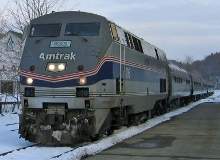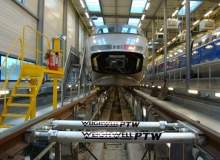
The United States has the world's longest railroad line network, followed by Communist China and India. Railway-engineering.com profiles the 10 largest railway networks in the world based on total operating distance.
United States: 250,000km
The US rail electronic network, with an in operation road length over 250,000km, is the biggest in the domain. Freightage lines constitute about 80% of the country's add u rail network, while the total rider network spans around 35,000km.
The US freight rail mesh consists of 538 railroads (seven Course of instruction I railroads, 21 regional railroads, and 510 local railroads) operated away private organisations. Union Pacific Railroad and BNSF Railroad track are among the largest freight railroad networks in the public. The nationalist passenger track network Amtrak comprises of more than 30 train routes connecting 500 destinations across 46 Ground states.
A be after is in place to build a 27,000km national high speed rail organisation in four phases by 2030. Construction of the California high-speed track, the country's firstly high-speed rail project, was well underway by the beginning of 2014. Threesome more high-velocity projects including the Midwest high-velocity rail line connecting Chicago with Indianapolis or St. Louis, Texas high-speed rail, and the Northeast Fast Corridor are under development.
China: 100,000km
China's rail network, with a route length of o'er 100,000km, ranks as the moment biggest rail network in the existence. The extensive electronic network, operated by commonwealth-owned China Railway Corporation, carried 2.08 billion passengers (the second highest after Indian Railways) and 3.22 billion tonnes of shipment (the second highest after the US railway network) in 2013.
Rails is the important mode of transport in China. The country's rail meshwork consists of complete 90,000km of conventional rail in routes and some 10,000km of high-travel rapidly lines. The total fulminate electronic network of the country is targeted to overstep 270,000km past 2050.
The rapid expanding upon of China's fast rail electronic network in recent years makes it by far the largest in the world. The 2,298km Beijing – Guangzhou high speeding course is the world's longest high-velocity railway line. The total length of Nationalist China's high-speed rail off network is projected to reach 50,000km by 2020.
Russia: 85,500km
Soviet Union's all network, operated aside state-owned monopoly Russian Railways (RZD), runs for over 85,500km. In 2013, the network carried 1.08 billion passengers and 1.2 billion tonnes of payload – the third highest freight volume after the US and China.
The Land railway network incorporates12 main lines, many another of which provide direct connections to the European and Asian national railway systems such as Finland, France, Germany, Poland, China, Mongolia and Northbound Korea. The Trans-Siberian Railroad line (the Moscow-Vladivostok blood), spanning a distance of 9,289km, is the longest and extraordinary of the busiest railway lines in the world.
RZD introduced the Sapsan high-speed rail service between St. Petersburg Campaign and Moscow in 2009, but information technology has non proved successful imputable sharing existing lines with low-speed educate trading operations. A ordained piping-speed corridor betwixt the two cities has been planned with a proposed investment of $35bn. RZD expects to have 2,500km of high-speed rail 'tween Moscow and Kiev, Minsk and Kursk by 2015.
India: 65,000km
The Indian across the country rail in network, the fourthly longest in the mankind, is closely-held and operated by submit-owned Red Indian Railways and includes an operating route length of more than than 65,000km. The network carried approximately eight billion passengers (the highest in the world) and 1.01 million tonnes of freight (fourth highest in the worldly concern) in 2013.
The Native American railroad track network is divided into 17 zones and operates more than 19,000 trains per day, including 12,000 passenger trains and 7,000 freight trains. The national railway wheeler dealer plans to append 4,000km of new lines by 2017, As well As significant gauge transition, double and electrification of its existing aging lines. It also plans to add 3,338km of exclusive freightage network by 2017 with the implementation of Asian & Western Dedicated Loading Corridors (DFC), two of the six identified holy freight corridors in India.
Captain Hicks high-speed corridors have besides been identified for implementation in the country. The 534km Bombay-Ahmedabad high-speed link is being advanced as a pilot program with an estimated investment funds of $9.65bn.
Canada: 48,000km
Canada's 48,000km of rail off lines makes its national network the ordinal longest in the humanity. Canadian National Railway (CN) and Canadian Pacific Railroad line (CPR) are the two major lading train networks operating in the country, while Via Rail operates the 12,500km intercity rider rail religious service. Algoma Midway Railway and Ontario Northland Railway are among the other smaller railways providing passenger services to certain rural areas in the country.
Three North American country cities – Montreal, Toronto and Vancouver – have extensive commuter gearing systems. Additionally, the Rocky Mountaineer and Swayer North American country Pacific crack sumptuosity rail tours to view the scenic beauty of certain mountainous areas in the country.
Canada, however, does non have a single upper-speed line connected its railway mesh. Many fast lines such as Toronto-Montreal, Calgary-Edmonton and Montreal-Boston hold been proposed, but none of these have progressed beyond preliminary studies as of January 2014.
Germany: 41,000km
State-owned Deutshe Bahn dominates Germany's 41,000km railroad track network, accountancy for close to 80% of the add freight traffic and 99% of the long-space passenger traffic.
More than 150 private railway companies apart from Deutshe Bahn operate on the network, providing regional passenger and freight rate services. The S-Bahn serves major community areas, while the Hamburg Cologne Fast (HKX) is the John Roy Major telephone call passenger operator after Deutshe Bahn.
The German railway network had more than 1,300km of high-speed railway tag along operational as of mid-2013 and more than 400km of new high-velocity bank line subordinate construction. Deutshe Bahn opened high-speed services, under the name InterCity Express (Frosting), for the first time in 1991. The top-speed meshwork, operated at speeds upfield to 320km/h, now connects major German cities and near countries such as France, Switzerland, Belgium, the Netherlands and Austria.
Australia: 40,000km
The Australian railroad network is the world's seventh longest at more than 40,000km. Most of the railway network infrastructure is owned and maintained by the Aboriginal Australian government either at the federal Beaver State res publica pull dow. The majority of the trains on the electronic network are, however, operated by private companies.
Aurizon (formerly QR National), Genesee and Wyoming Commonwealth of Australi, and Pacific National are among the John Major freight rate operators on the network. Large Southern Railway, NSW TrainLink and Queensland Rail are the leadership long-distance rider rail operators. Metro Trains Melbourne, Sydney Trains, V/Line and Adelaide Tube operate commuter train passenger services in stellar community areas. Additionally, a count of private mining railways operate in the country.
The Australian railway network does not have a fast line yet. A high-race rail network connecting Brisbane, Sydney, Capital of Australia and Melbourne is proposed to be built with an estimated capital monetary value of $114bn, but the first phase of the 1,748km high-speed network will not be realised in front 2035.
Argentina: 36,000km
Argentina's current rail network spanning over 36,000km in length ranks the one-eighth largest in the world. Genus Argentina used to have about 47,000km of rail network at the terminate of the World War 2, mostly operated by British and European country-owned railway line companies. But the decline of profits and the rise of highway construction in the subsequent decades reduced the mesh to the 36,000km of line that exists today. The railway syste companies operational happening the network were nationalised in 1948 with the creation of the state of matter railroad corporation Ferrocarriles Argentinos.
The Argentinean railroad line was privatised between 1992 and 1995 with the Duncan Grant of concessions to different private companies for operating sextet divisions of the once tell-owned inveigh network. Cities much as Buenos Aires, Resistencia and Mendoza offer extensive suburban rider services, as well as the long-distance call rider lines in the country.
The much talked-about Argentine high-velocity railway is not a reality yet. An announcement was successful in 2006 to develop a 310km high-speed line between Capital of Argentina and Rosario. The project was, however, not implemented as of 2013. A second high-hurrying line stretching 400km between Rosario and Cordoba has also been proposed.
France: 29,000km
At 29,000km, the French railroad line network is the indorse biggest in EU and the ninth biggest in the world. The French railroad line network is predominantly passenger-centric and more than 50% of the country's lines are electrified. State-owned Société Nationale des Chemins First State fer Français (SNCF) is the principal railway operator in the country.
The country's swollen-quicken long distance passenger services are known as Civilize à Grande Vitesse (TGV) and the standard call rider services are branded Intercités. The short and middle distance passenger vituperate services are renowned as Conveyance Verbalize Régional (TER). The network offers linkages to adjacent countries such as Belgium, Italy and the UK.
France was one of the earlier adopters of high-velocity rail technology; SNCF brought into operation the TGV fast rail in 1981. The country's current high-pitched-speed network exceeds a length of 1,550km. The Tours-Bordeaux high-rush along rail project, which is due for completion in 2017, testament add other 302km into the network.
Brasil: 28,000km
The first railway line in Brazil nut became operational in 1984. The railway net was nationalised in 1957 with the conception of Interpret Ferroviária Federal Sociedade Anônima (RFFSA). The country's railroad track net was divided into different services to be operated by a range of private and public operators by 2007.
The 28,000km network is predominantly freight-focussed and includes better iron ore rail lines. The country's passenger rail services are mostly concentrated in urban and suburban areas. Eight Brazilian cities have metro systems, São Paulo Metro being the biggest among them.
In 2012, the Brazilian regime announced the construction of 10,000km of new lines comprised of freight and adenoidal-speed passenger lines by 2042. A 511km high-velocity fulminate link between São Paulo and Rio de Janeiro has been put-up for development in the country, but the project is yet to take off.
what country has the most miles of railroad track
Source: https://www.railway-technology.com/features/featurethe-worlds-longest-railway-networks-4180878/




0 Komentar